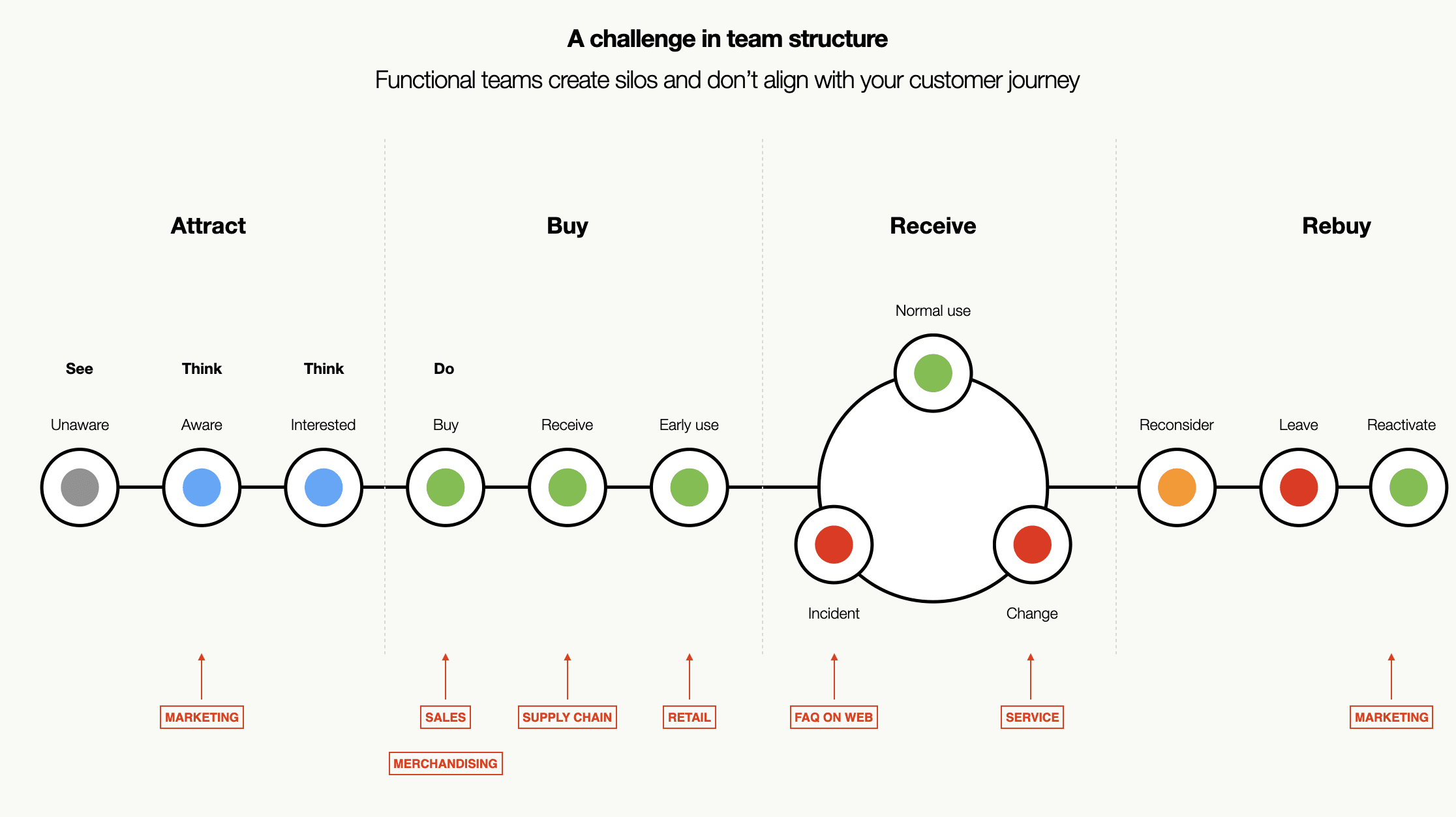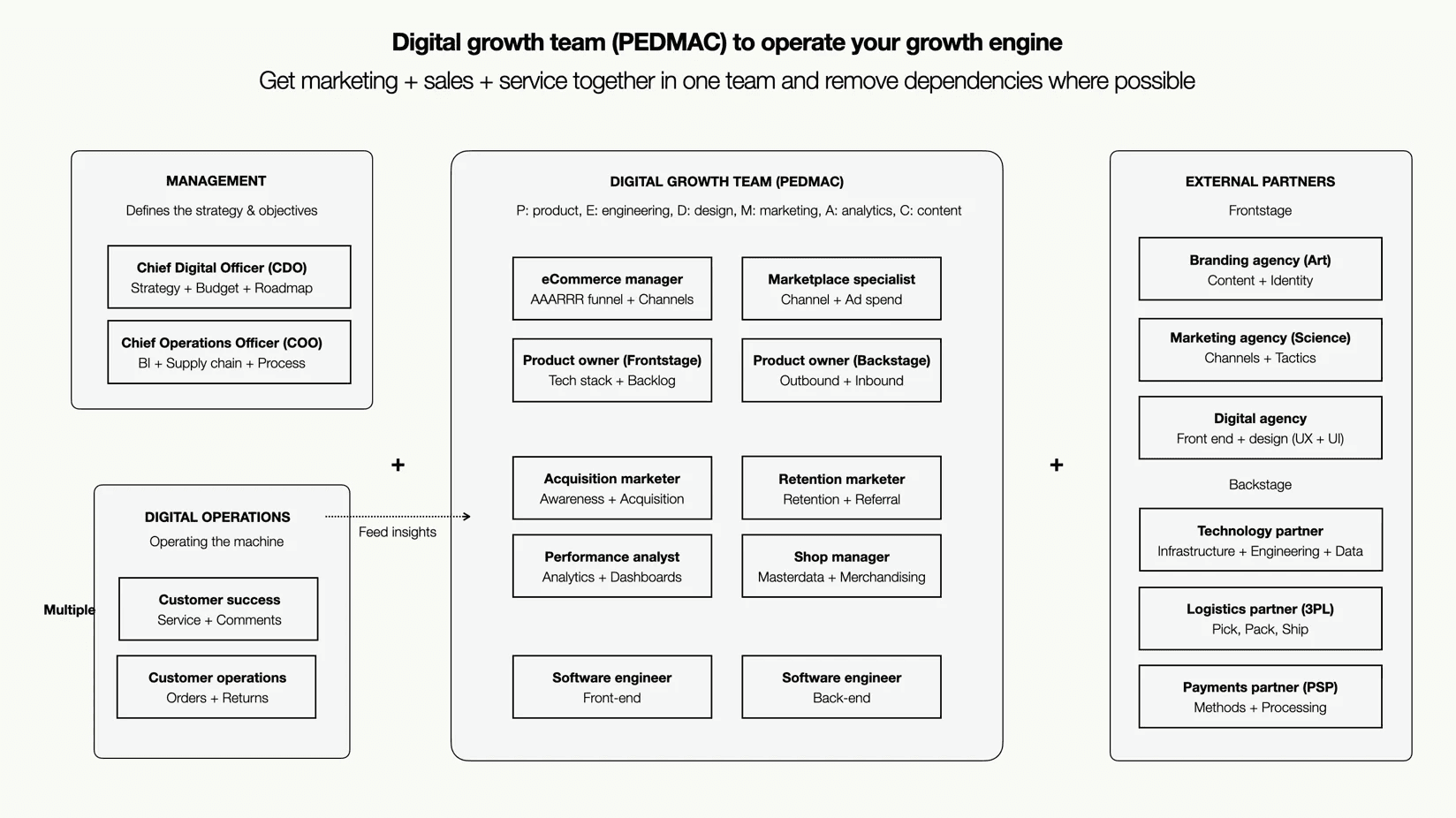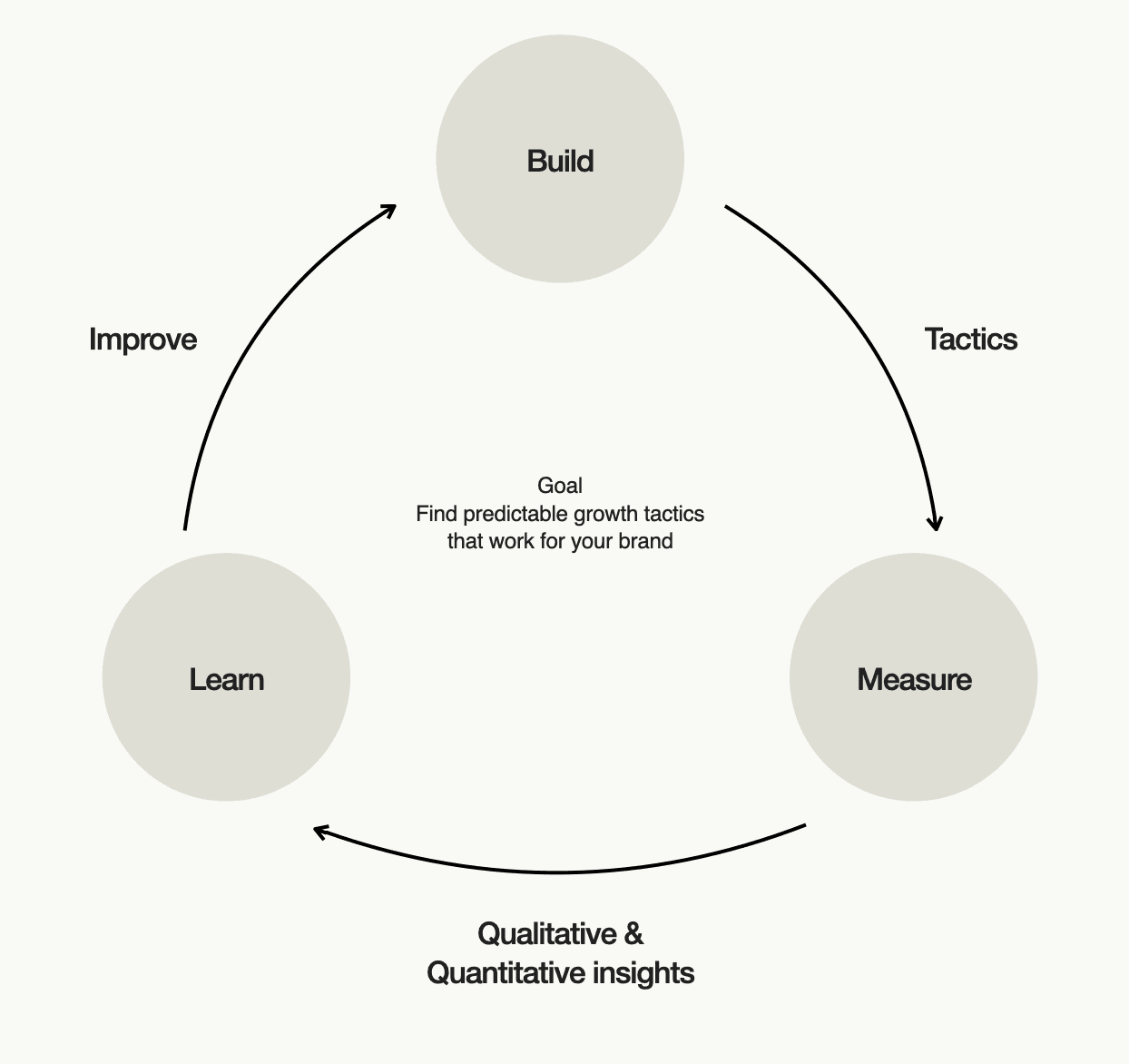


Aug 9, 2023
Aug 9, 2023
Webinar key takeaways | Building an e-commerce growth engine (part II)
Webinar key takeaways | Building an e-commerce growth engine (part II)

Written By
Written By
Aurelija Vycaite
Aurelija Vycaite
Webinars
Welcome back to the second instalment of our series in which we're diving deeper into Jons Janssens's insights from his webinar "Building an e-commerce growth engine". If you missed out on the foundational discussion about the growth engine, its structure, and how to construct an effective funnel, head over to Part I.
Today, we'll delve further into incorporating the growth funnel in your organization. We'll discuss setting up digital teams, aligning them, and creating a growth backlog—a list of tactics to enhance the growth funnel.
If you want to download our growth backlog template, find it here.
If you want to watch the recording of the full webinar "Building an e-commerce growth engine", find it here.

Welcome back to the second instalment of our series in which we're diving deeper into Jons Janssens's insights from his webinar "Building an e-commerce growth engine". If you missed out on the foundational discussion about the growth engine, its structure, and how to construct an effective funnel, head over to Part I.
Today, we'll delve further into incorporating the growth funnel in your organization. We'll discuss setting up digital teams, aligning them, and creating a growth backlog—a list of tactics to enhance the growth funnel.
If you want to download our growth backlog template, find it here.
If you want to watch the recording of the full webinar "Building an e-commerce growth engine", find it here.

How to set up your digital teams for growth funnel implementation?
How to set up your digital teams for growth funnel implementation?
As discussed in part I, one of the key principles of the growth engine is creating a customer experience that is guiding the user towards the right purchasing decision. For this purpose you need to implement a core shopping journey that helps the user to navigate on the website seamlessly and discover different products, services, and other features that are most relevant. For putting such digital experience into place, a cross-functional digital team is needed. So, how to set it up for best results and alignment?
As discussed in part I, one of the key principles of the growth engine is creating a customer experience that is guiding the user towards the right purchasing decision. For this purpose you need to implement a core shopping journey that helps the user to navigate on the website seamlessly and discover different products, services, and other features that are most relevant. For putting such digital experience into place, a cross-functional digital team is needed. So, how to set it up for best results and alignment?
As discussed in part I, one of the key principles of the growth engine is creating a customer experience that is guiding the user towards the right purchasing decision. For this purpose you need to implement a core shopping journey that helps the user to navigate on the website seamlessly and discover different products, services, and other features that are most relevant. For putting such digital experience into place, a cross-functional digital team is needed. So, how to set it up for best results and alignment?
As discussed in part I, one of the key principles of the growth engine is creating a customer experience that is guiding the user towards the right purchasing decision. For this purpose you need to implement a core shopping journey that helps the user to navigate on the website seamlessly and discover different products, services, and other features that are most relevant. For putting such digital experience into place, a cross-functional digital team is needed. So, how to set it up for best results and alignment?
The risk of a growing team
The risk of a growing team
In a small company, a company grows, there's an increased risk of various aspects of the customer journey falling under isolated teams. The challenge—and the goal—is to unify these teams with a singular objective: crafting a seamless and smooth customer experience. Most e-commerce or consumer-oriented companies initiate operations with a compact, unified team. There is often a single person wearing many hats and overlooking whole areas of strategy and operations. However, as a company expands, this tight-knit team often disperses into separate functional departments.
While this division can help specialise roles, it often diminishes the agility that smaller teams possess. There's an increased risk of various aspects of the customer journey falling under isolated teams. Siloed departments can lose sight of the overarching customer journey, which should be the central focus.

The biggest challenge and the goal here is to maintain a cross-functional alignment that consistently involves all functions—marketing, sales, and service— so you are better positioned to effectively troubleshoot issues and capture opportunities in the customer journey. A holistic approach, which can be visualised as a comprehensive customer journey from initial awareness to potential repurchase, ensures that everyone remains aligned. Although it's not necessary to restructure the entire organisation, maintaining regular cross-functional team meetings (i.e., bi-weekly) would foster this alignment.
From our experience, a balanced team would ideally blend product, engineering, design, marketing, analytics, and content expertise—often referred to as the "PEDMAC" setup. The challenge lies in ensuring that these specialised roles still operate in synergy, even if spread across different departments.

Improve cross-functional alignment in your organization:
1. Gather your team and map out your customer journey;
2. Identify what functions (i.e., sales, marketing, supply chain) are responsible for the success of the customer journey stages;
2. Build a team with members from each function. Use the "PEDMAC" setup as guidance;
3. Discuss the customer journey together, the hotspots and opportunities for improvement in it together;
4. Keep the rhythm going: bi-weekly meetings should be enought to maintain alignment.
In a small company, a company grows, there's an increased risk of various aspects of the customer journey falling under isolated teams. The challenge—and the goal—is to unify these teams with a singular objective: crafting a seamless and smooth customer experience. Most e-commerce or consumer-oriented companies initiate operations with a compact, unified team. There is often a single person wearing many hats and overlooking whole areas of strategy and operations. However, as a company expands, this tight-knit team often disperses into separate functional departments.
While this division can help specialise roles, it often diminishes the agility that smaller teams possess. There's an increased risk of various aspects of the customer journey falling under isolated teams. Siloed departments can lose sight of the overarching customer journey, which should be the central focus.

The biggest challenge and the goal here is to maintain a cross-functional alignment that consistently involves all functions—marketing, sales, and service— so you are better positioned to effectively troubleshoot issues and capture opportunities in the customer journey. A holistic approach, which can be visualised as a comprehensive customer journey from initial awareness to potential repurchase, ensures that everyone remains aligned. Although it's not necessary to restructure the entire organisation, maintaining regular cross-functional team meetings (i.e., bi-weekly) would foster this alignment.
From our experience, a balanced team would ideally blend product, engineering, design, marketing, analytics, and content expertise—often referred to as the "PEDMAC" setup. The challenge lies in ensuring that these specialised roles still operate in synergy, even if spread across different departments.

Improve cross-functional alignment in your organization:
1. Gather your team and map out your customer journey;
2. Identify what functions (i.e., sales, marketing, supply chain) are responsible for the success of the customer journey stages;
2. Build a team with members from each function. Use the "PEDMAC" setup as guidance;
3. Discuss the customer journey together, the hotspots and opportunities for improvement in it together;
4. Keep the rhythm going: bi-weekly meetings should be enought to maintain alignment.
Developing the roadmap: how to create a growth backlog?
Developing the roadmap: how to create a growth backlog?
There's no one-size-fits-all approach when it comes to predicting what growth tactics will resonate with your target audience. Brands cannot rely solely on external expertise. Instead, the most reliable way to discover what’s most effective is continuous testing, iterating, and learning. For this purpose, the growth engine needs a growth backlog.
Simply put, a growth backlog is a list of tactics a brand intends to test to determine their efficacy. All the tactics need to be constantly updated and adjusted, making the growth backlog a living document.The process of implementing the growth backlog, therefore, mirrors the build-measure-learn loop.
There's no one-size-fits-all approach when it comes to predicting what growth tactics will resonate with your target audience. Brands cannot rely solely on external expertise. Instead, the most reliable way to discover what’s most effective is continuous testing, iterating, and learning. For this purpose, the growth engine needs a growth backlog.
Simply put, a growth backlog is a list of tactics a brand intends to test to determine their efficacy. All the tactics need to be constantly updated and adjusted, making the growth backlog a living document.The process of implementing the growth backlog, therefore, mirrors the build-measure-learn loop.
Developing the roadmap: how to create a growth backlog?
Developing the roadmap: how to create a growth backlog?
There's no one-size-fits-all approach when it comes to predicting what growth tactics will resonate with your target audience. Brands cannot rely solely on external expertise. Instead, the most reliable way to discover what’s most effective is continuous testing, iterating, and learning. For this purpose, the growth engine needs a growth backlog.
Simply put, a growth backlog is a list of tactics a brand intends to test to determine their efficacy. All the tactics need to be constantly updated and adjusted, making the growth backlog a living document.The process of implementing the growth backlog, therefore, mirrors the build-measure-learn loop.

1.) The brand builds (implements a feature or tactic);
2.) Then measures its performance through both qualitative (UX reviews, customer feedback) and quantitative means (analytical data);
3.) And finally learns from these insights.
This feedback loop helps brands refine their tactics or introduce new ones that cater specifically to their target audience's preferences.
There's no one-size-fits-all approach when it comes to predicting what growth tactics will resonate with your target audience. Brands cannot rely solely on external expertise. Instead, the most reliable way to discover what’s most effective is continuous testing, iterating, and learning. For this purpose, the growth engine needs a growth backlog.
Simply put, a growth backlog is a list of tactics a brand intends to test to determine their efficacy. All the tactics need to be constantly updated and adjusted, making the growth backlog a living document.The process of implementing the growth backlog, therefore, mirrors the build-measure-learn loop.

1.) The brand builds (implements a feature or tactic);
2.) Then measures its performance through both qualitative (UX reviews, customer feedback) and quantitative means (analytical data);
3.) And finally learns from these insights.
This feedback loop helps brands refine their tactics or introduce new ones that cater specifically to their target audience's preferences.
Visualising the growth backlog
Visualising the growth backlog
When working with a digital team, the growth backlog should become a constantly updated list of shared and delegated responsibilities. Together with the funnel performance review, the growth backlog helps decide on which tactics to prioritise to create the biggest impact. By rallying your team around this structure, and regularly reviewing and refining it, you ensure that every member understands their role and the larger vision.
You can find and use the growth backlog template by us here.

Another important principle is focusing on growing the core of your business proposition before branching out. While it's tempting to diversify into new markets or introduce novel business models, it's imperative to solidify your foundational growth engine. The digital landscape is rife with opportunities, but without a clear plan and a keen understanding of your brand's unique selling points, you risk diluting your efforts.
When working with a digital team, the growth backlog should become a constantly updated list of shared and delegated responsibilities. Together with the funnel performance review, the growth backlog helps decide on which tactics to prioritise to create the biggest impact. By rallying your team around this structure, and regularly reviewing and refining it, you ensure that every member understands their role and the larger vision.
You can find and use the growth backlog template by us here.

Another important principle is focusing on growing the core of your business proposition before branching out. While it's tempting to diversify into new markets or introduce novel business models, it's imperative to solidify your foundational growth engine. The digital landscape is rife with opportunities, but without a clear plan and a keen understanding of your brand's unique selling points, you risk diluting your efforts.
Create a growth backlog in your organization:
Create a growth backlog in your organization:
1. Together with your cross-functional team identify the tactics you want to try to improve the customer journey;
2. Identify the goals and metrics that would be used to track the tactic's effectiveness (i.e., traffic, LTV, conversion rate);
3. Estimate the effort needed to implement the tactics and the impact (value) of them;
4. Rank the tactics from highest impact/lowest effort to lowest effort/highest impact;
5. Decide which tactics you want to implement in the next period;
6. Continue the build-measure-learn loop: evaluate which tactics were effective and what new tactics to introduce. Make sure you are constantly updating the growth backlog.
1. Together with your cross-functional team identify the tactics you want to try to improve the customer journey;
2. Identify the goals and metrics that would be used to track the tactic's effectiveness (i.e., traffic, LTV, conversion rate);
3. Estimate the effort needed to implement the tactics and the impact (value) of them;
4. Rank the tactics from highest impact/lowest effort to lowest effort/highest impact;
5. Decide which tactics you want to implement in the next period;
6. Continue the build-measure-learn loop: evaluate which tactics were effective and what new tactics to introduce. Make sure you are constantly updating the growth backlog.
Conclusion
To be able to find the growth tactics that will work for your brand you need to align your team around the same scoreboard and implement a ‘build, measure, learn’ loop that is executed by a cross-functional team. Combined with a technology stack that can provide the rails for your customer journey and the infrastructure for your growth ambition.
Remember that growth isn't just about numbers or short-term gains. It's about building a sustainable business model, fostering a loyal customer base, and continuously innovating to stay ahead of the curve. The strategies we discussed today are not just tools, but a mindset, a way of thinking that places growth at the center of every business decision. Adopting this mindset will not only propel your brand forward but will also ensure its longevity in a competitive marketplace.
Stay in the loop
Subscribe to our newsletter to learn how to build world-class digital experiences and get fit for digital growth.

Stay in the loop
Subscribe to our newsletter to learn how to build world-class digital experiences and get fit for digital growth.

Stay in the loop
Subscribe to our newsletter to learn how to build world-class digital experiences and get fit for digital growth.

Stay in the loop
Subscribe to our newsletter to learn how to build world-class digital experiences and get fit for digital growth.
